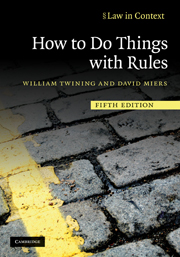Book contents
- Frontmatter
- Contents
- Preface
- Online appendices
- Acknowledgements
- Abbreviations
- Table of statutes and legislative instruments
- Table of cases
- Part I
- Part II Reading, using and interpreting rules in general
- Part III Reading law: reading, using and interpreting legislation and cases
- Part IV
- Index
- Resources on the web
- Appendix I Supplementary materials and exercises on Chapter 1
- Appendix II Normative and legal pluralism
- Appendix III Visual presentation of rules
- Appendix IV The Reading Law Cookbook
- Appendix V Supplementary materials and exercises on Chapters 7–10
- Appendix VI Supplementary materials and exercises on Chapters 9 and 11
- Appendix VII Domestic violence: a case study
- Appendix VIII MPs' expenses: a case study
- Appendix IX Hunting Act 2004: a case study
Appendix VI - Supplementary materials and exercises on Chapters 9 and 11
Published online by Cambridge University Press: 05 June 2012
- Frontmatter
- Contents
- Preface
- Online appendices
- Acknowledgements
- Abbreviations
- Table of statutes and legislative instruments
- Table of cases
- Part I
- Part II Reading, using and interpreting rules in general
- Part III Reading law: reading, using and interpreting legislation and cases
- Part IV
- Index
- Resources on the web
- Appendix I Supplementary materials and exercises on Chapter 1
- Appendix II Normative and legal pluralism
- Appendix III Visual presentation of rules
- Appendix IV The Reading Law Cookbook
- Appendix V Supplementary materials and exercises on Chapters 7–10
- Appendix VI Supplementary materials and exercises on Chapters 9 and 11
- Appendix VII Domestic violence: a case study
- Appendix VIII MPs' expenses: a case study
- Appendix IX Hunting Act 2004: a case study
Summary
Note: we have combined the supplementary materials and exercises on these two chapters in this Appendix because both make substantial reference to the House of Lords' decision in Donoghue v. Stevenson [1932] AC 562
Chapter 9 Reading cases
Donoghue v. Stevenson [1932] AC 562
Introduction
Donoghue v. Stevenson is one of the most famous cases in the common law. It is frequently used to illustrate points about matters that fall within the compass of this book. It is thus a useful link with the existing literature on a number of topics. It also provides a good illustration of many other relevant points to which less attention has been paid in the past. Because of pressure of space, we have not been able to reproduce the two speeches of Lord Buckmaster and Lord Atkin in their entirety. We have selected certain passages from the report, which are extensively referred to, especially in Chapters 9 and 11, in order to illustrate at this stage some of the fundamental aspects of rules extracted from judicial decisions, notably the notion of a ‘ladder of abstraction’ and techniques for handling precedents.
By using the link here readers can access extracts from the law report of Donoghue v. Stevenson, in particular from the speeches of Lords Atkin and Buckmaster. It is important that you study the extracts closely; in particular, compare the level of generality at which the facts, the issue and the decision of the case are stated in the different extracts.
- Type
- Chapter
- Information
- How to Do Things with Rules , pp. 476 - 486Publisher: Cambridge University PressPrint publication year: 2010



